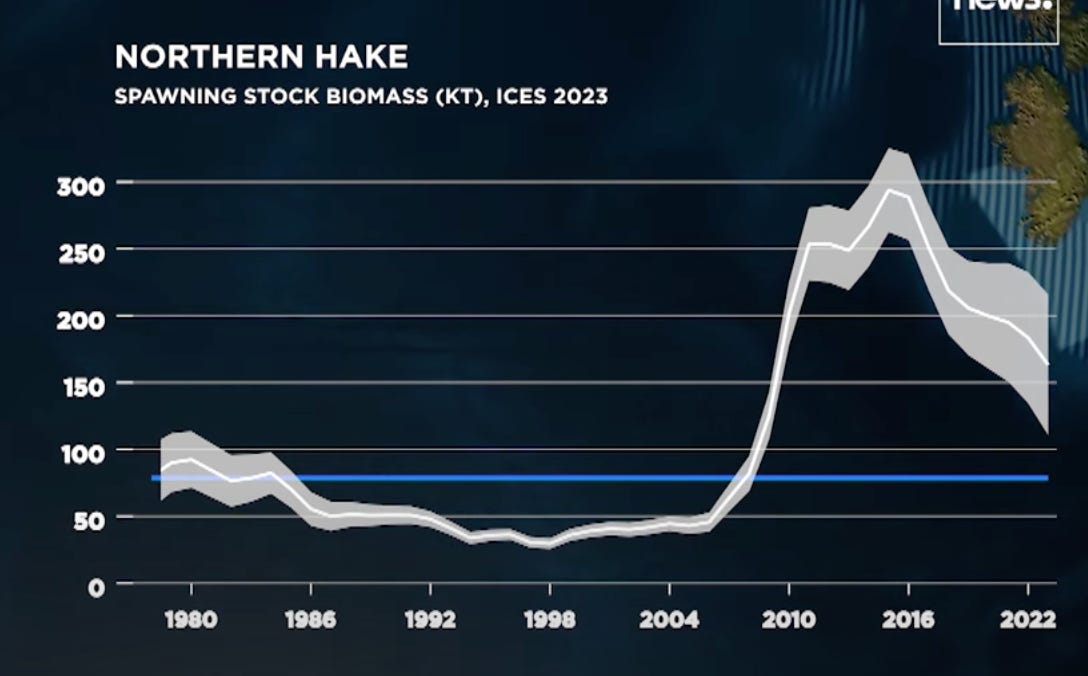Wild Fisheries Will Provide, If We Let Them
Examples of fishery resilience are everywhere, but we can't let our guard down.

In my last post, I wrote, "The Future of Seafood is on Land." While you can't argue with the numbers that aquaculture produces more seafood than wild fisheries (by a lot), the whole concept is a bit of a bummer.
When I first began looking at the ocean economy I was ready to swear off fish altogether. But in the end, I just want to eat wild-caught fish, actually from the ocean, from a sustainably managed fishery.
Is that so much to ask for?
Taking a look, I found some examples about how dramatically fisheries can improve if we implement the right policies. They also highlight the importance of getting the local fishing communities on board.
After all, if a fishery is closed we just switch from one food to another and continue with our lives. In the meantime, we’re asking others to curtail their livelihoods for a decade or so while the fish do their thing.
But as the successes add up, getting the fishing community on board gets easier. If it works, the investment pays off big and sets an entire community on a sustainable path while providing the world with excellent, healthy, low-carbon food.
Here's an interesting case.
This story outlines the remarkable rebound of the hake population in the Atlantic coast of Europe. Yet, is it really "remarkable?" Or just what nature does.
When you look at the measures implemented to save the fish population from collapse in the early 2000s, it seems pretty straightforward:
strict catch limits
larger net sizes to let young fish escape
establishing protected areas for the young fish to grow
Giving young fish a chance to reach maturity is critical to allowing fish populations to rebound, which makes sense.
But this was the result (screenshot from the video above):
Pretty dramatic.
This story highlights the potential of sustainably managed fisheries. They don't just level off. They have the potential to thrive and become an abundant, sustainable food source for the planet.
As it turns out, there are other similar success stories.
This 2012 article from Pew highlights five rebuilt fisheries in the U.S., including New England Scallops, Mid-Atlantic Bluefish, Pacific Lingcod, and Mid-Atlantic Summer Flounder. It lists the Gulf Red Snapper as "showing promise."
A more recent NOAA story boasted of its 50th successful fish stock rebuild. This one, the Snohomish coho salmon, was declared overfished in 2018. And by 2023, it's good to go? Pretty shocking.
Rockfish, a major fishery on the west coast, was declared overfished in 2000 and rebuilt by 2015.
These fisheries are rebuilt one by one using the same three-step playbook: impose strict quotas, identify where young fish are being caught (in the case of Gulf Redfish, it was actually shrimp trawlers), and establish protected areas for them to grow.
Simple. But not easy.
"The way to make things really sustainable is to make them really, really unpleasant for a while."
-Togue Brawn, fishery manager and fishing boat owner
Those 10-20 years are painful for the local fishing community.
However, the more success stories they see, the easier it is to take a longer-term view.
"They guys believe that it works."
Listen: What Fish Stock Rebuilding Means to Communities - NOAA
Some fishing communities have implemented similar measures independently, imposing their own short-term pain for the long-term gain of their families and way of life.
In the video below, when The Nature Conservancy visited some small-scale fishing communities in Peru, they were already implementing their own conservation efforts.
The methods they enacted sound similar to what the scientists recommend, and why not. These fishermen are the true experts.
1996 Sustainable Fisheries Act (Amendment to Mag Stevenson Act)
These stories have a common timeline: they identified the problem in the 1990s, implemented the solution in the early 2000s, and saw improvement 10-20 years later.
In the U.S., this is because of the Sustainable Fisheries Act that was passed in 1996, which was an amendment to the critical Magnusun-Stevens Fishery Conservation and Management Act of 1976.
The Magnusun-Stevens Act expanded U.S. territorial waters from 12 to 200 miles, helping to end foreign fleets' pillaging of our fisheries. However, this just left domestic fishers free to expand their operations.
The Sustainable Fisheries Act took things further by requiring overfished fisheries to be rebuilt. It also considered habitat, requiring "Essential Fish Habitats" to be restored.
Despite the widespread view that these acts were critical successes for our nation's fisheries, the Republican-controlled Congress watered them down in 2018.
When it comes to the oceans, even success stories aren't permanent. When the fish show up, industry just can’t wait to get their hands on them.
+Bluefin tuna are returning to UK waters so why is the Government so eager to kill them? - Blue Planet Society
Favorable Ocean Conditions
"A lot of things are outside of our control, and ocean conditions are primary."
-Brad Pettinger, chair of the Pacific Fishery Management Council and vessel owner
Another critical element mentioned in every fisheries success story might become more of an issue going forward - favorable ocean conditions.
You can stop fishing all you want, but if the ocean environment isn't healthy enough for fish to grow in, then we all have a serious problem.




Pretty interesting to learn they were already doing what the science recommends.
Always informative. We have to find hope in this. Especially appreciated the Peruvian fishermen’s efforts. Well done.